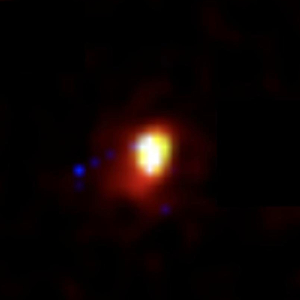The Webb Telescope is unstoppable: Galaxies from the 235-million-year-old universe
The James Webb Space Telescope caught a candidate for the record-distant galaxy CEERS-93316. We observe it in space only 235 million years after the Big Bang. The actual distance of this object at redshift z = 16.7 is about 35 billion light years, due to the expansion of the Universe.
–
The candidate galaxy CEERS-93316. Credit: Sophie Jewell/Clara Pollock.
–
It hasn’t even been a month since US President Joe Biden released the first full-scale image of the James Webb Space Telescope, and we’re already being bombarded with one interesting discovery after another. The latest catch of the new ultimate telescope is a galaxy with an unashamedly high redshift of z = 16.7.

Callum Donnan. Credit: C. Donnan.
–
Callum Donnan from the UK’s University of Edinburgh and his colleagues tracked down the galaxy, or rather the galaxy candidate CEERS-93316. If it is confirmed to be a galaxy and its distance is correct, it will be a galaxy we observe in space just 235 million years after the Big Bang. Considering the age of the universe, this means that the light of this galaxy has been traveling to us for about 13.56 billion years.
How about the distance of candidate galaxy CEERS-93316? The answer in similar cases is rather complicated. The stated 13.56 billion light years represents the “light travel distance”. However, the actual distance (proper distance) is considerably greater, roughly 35 billion light years. It is given by the expansion of the universe.
 –
–
Logo. Kredit: University of Edinburgh.
–
A galaxy from space 235 million years old is a fascinating sight. This is very close to the time when we think the first galaxies were just starting to form and only about 135 million years after the first stars in the universe. Anything with a redshift greater than 10 is observed in a universe that was only a few hundred million years old. So far we know of only one confirmed galaxy at this distance. It is the galaxy GN-z11, discovered a few years ago, whose redshift was measured by the Hubble telescope and the Keck I telescope at z = 11.
The Webb Telescope is particularly suitable for observing record-distant galaxies from the dawn of space. It is equipped with extensive optics that capture a lot of incoming radiation. It also has infrared observing systems, so it can observe ancient, very faint and red galaxies at huge redshifts, better than other powerful telescopes. Experts predict that the new record may not last long. The Webb telescope is at least theoretically capable of detecting galaxies with a redshift greater than 20, i.e. in space not even 200 million years after the Big Bang.
Literature
–


